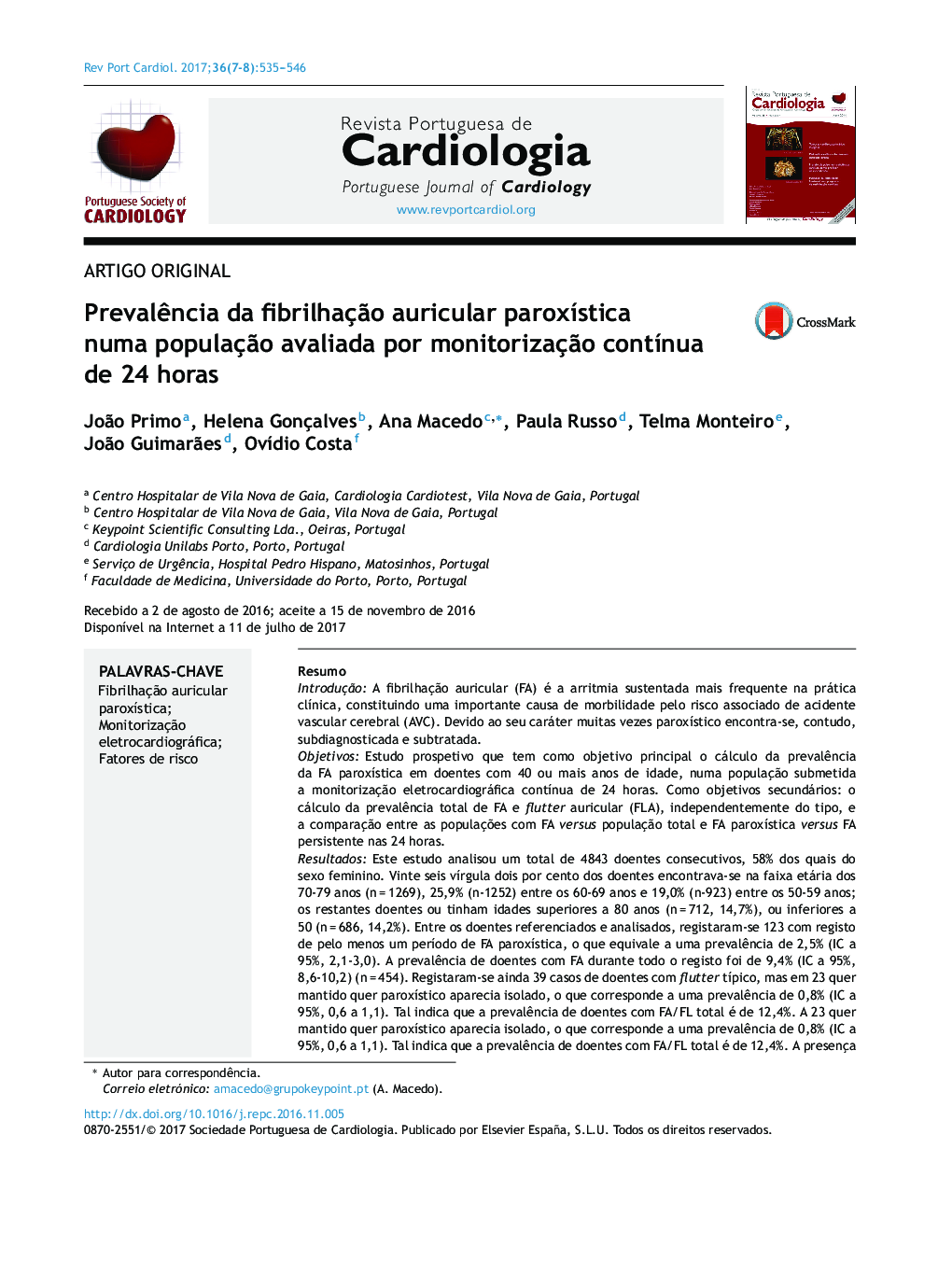| کد مقاله | کد نشریه | سال انتشار | مقاله انگلیسی | نسخه تمام متن |
|---|---|---|---|---|
| 5126426 | 1488569 | 2017 | 12 صفحه PDF | دانلود رایگان |

ResumoIntroduçãoA fibrilhação auricular (FA) é a arritmia sustentada mais frequente na prática clÃnica, constituindo uma importante causa de morbilidade pelo risco associado de acidente vascular cerebral (AVC). Devido ao seu caráter muitas vezes paroxÃstico encontraâse, contudo, subdiagnosticada e subtratada.ObjetivosEstudo prospetivo que tem como objetivo principal o cálculo da prevalência da FA paroxÃstica em doentes com 40 ou mais anos de idade, numa população submetida a monitorização eletrocardiográfica contÃnua de 24 horas. Como objetivos secundários: o cálculo da prevalência total de FA e flutter auricular (FLA), independentemente do tipo, e a comparação entre as populações com FA versus população total e FA paroxÃstica versus FA persistente nas 24 horas.ResultadosEste estudo analisou um total de 4843 doentes consecutivos, 58% dos quais do sexo feminino. Vinte seis vÃrgula dois por cento dos doentes encontravaâse na faixa etária dos 70â79 anos (n = 1269), 25,9% (nâ1252) entre os 60â69 anos e 19,0% (nâ923) entre os 50â59 anos; os restantes doentes ou tinham idades superiores a 80 anos (n = 712, 14,7%), ou inferiores a 50 (n = 686, 14,2%). Entre os doentes referenciados e analisados, registaramâse 123 com registo de pelo menos um perÃodo de FA paroxÃstica, o que equivale a uma prevalência de 2,5% (IC a 95%, 2,1â3,0). A prevalência de doentes com FA durante todo o registo foi de 9,4% (IC a 95%, 8,6â10,2) (n = 454). Registaramâse ainda 39 casos de doentes com flutter tÃpico, mas em 23 quer mantido quer paroxÃstico aparecia isolado, o que corresponde a uma prevalência de 0,8% (IC a 95%, 0,6 a 1,1). Tal indica que a prevalência de doentes com FA/FL total é de 12,4%. A presença de alguma forma de FA/FLA correlacionouâse significativamente com sexo masculino (p < 0,001) e idade (sobretudo nas classes etárias dos 70â79 anos e > 80 anos) (p < 0,001), com hipertensão arterial (p < 0,001). Este grupo tem uma prevalência significativamente maior de antecedentes de AVC (p = 0,001), 56 pacientes (9,3%), bem como de enfarte agudo do miocárdio, 5,3% (p < 0,001). Ao comparar a população de doentes com FA paroxÃstica e FLA paroxÃstico (FA/FLp) versus FA persistente, verificaramâse diferenças significativas (p < 0,05) entre ambos nos seguintes parâmetros: prevalência significativamente maior de FA/FLp nos indivÃduos situados nas classes etárias mais jovens (entre os 40â49, 50â59 e 60â69 anos), e significativamente menor nos indivÃduos situados nas classes etárias dos 70â79 anos e > 80 anos (p < 0,001); prevalência significativamente maior de antecedentes de AVC (p = 0,024) e significativamente menor de hipertensão arterial (p < 0,001). Apenas 12,8% dos que apresentavam FA paroxÃstica estavam hipocoagulados.ConclusõesA prevalência da FA paroxÃstica encontrada numa população submetida por motivos não selecionados a monitorização eletrocardiográfica de 24 horas é de 2,5% e a prevalência total de FA/FLA é de 12,4%. A FA paroxÃstica afeta doentes mais jovens, sendo menos dependente de fatores de risco, como hipertensão arterial. Correlacionaâse com percentagens significativamente superiores de AVC. A deteção sistemática destes doentes é um importante problema de saúde pública sendo diagnóstico precoce essencial na definição de candidatos para hipocoagulação oral e tratamento por ablação por cateter, a qual apresenta uma elevada taxa de sucesso curativa quando aplicada nesta fase.
IntroductionAtrial fibrillation (AF) is the most common sustained arrhythmia in clinical practice and a major cause of morbidity, due to the associated risk of stroke. However, since it is often paroxysmal, it is commonly underdiagnosed and undertreated.ObjectivesThe primary objective of this prospective study was to determine the prevalence of paroxysmal atrial fibrillation (PAF) in patients aged 40 and above in a population who underwent continuous 24âhour electrocardiographic monitoring. The secondary objectives were to determine the overall prevalence of AF/atrial flutter (AFL) regardless of the type and to compare the population with AF with the general population and patients with PAF with patients with AF.ResultsA total of 4843 consecutive patients were analyzed, 58% women, 26.2% aged 70â79 years (n=1269), 25.9% (n=1252) aged 60â69 years, and 19.0% (n=923) aged 50â59 years; the others were aged either >80 years (n=712, 14.7%) or <50 years (n=686, 14.2%). At least one episode of PAF was detected in 123 patients, a prevalence of 2.5% (95% CI: 2.1â3.0). The prevalence of persistent AF throughout the monitoring period was 9.4% (95% CI: 8.6â10.2) (n=454). Additionally, 39 cases of typical AFL were detected, but in 23 of them (sustained or paroxysmal) this appeared isolated, a prevalence of 0.8% (95% CI: 0.6â1.1). The overall prevalence of AF/AFL was thus 12.4%. The presence of some type of AF/AFL was significantly correlated with male gender (p<0.001), age (especially in the 70â79 and >80 ageâgroups) (p<0.001) and hypertension (p<0.001). This group had a significantly higher prevalence of previous stroke (56 patients [9.3%], p=0.001) and acute myocardial infarction (5.3%, p<0.001). Comparing the population with PAF and/or paroxysmal AFL (PAF/PAFL) to those with persistent AF (during 24âhour monitoring), significant differences were found: a higher prevalence of PAF/PAFL in younger individuals (40â49, 50â59 and 60â69 ageâgroups) and lower in older individuals (70â79 and >80 ageâgroups) (p<0.001), higher prevalence of history of stroke (p=0.024), and lower levels of hypertension (p<0.001). Only 12.8% of patients with PAF were taking anticoagulant drugs.ConclusionsThe prevalence of PAF found in a population referred for continuous 24âhour electrocardiographic monitoring for diverse reasons was 2.5% and the overall AF/AFL prevalence was 12.4%. PAF was more prevalent in younger patients. Patients with PAF showed a significantly lower prevalence of hypertension and significantly higher rates of stroke. Systematically detecting patients with PAF is a major public health concern, since early diagnosis is essential to identify candidates for oral anticoagulation and catheter ablation, which is frequently curative when applied at this stage.
Journal: Revista Portuguesa de Cardiologia - Volume 36, Issues 7â8, JulyâAugust 2017, Pages 535-546